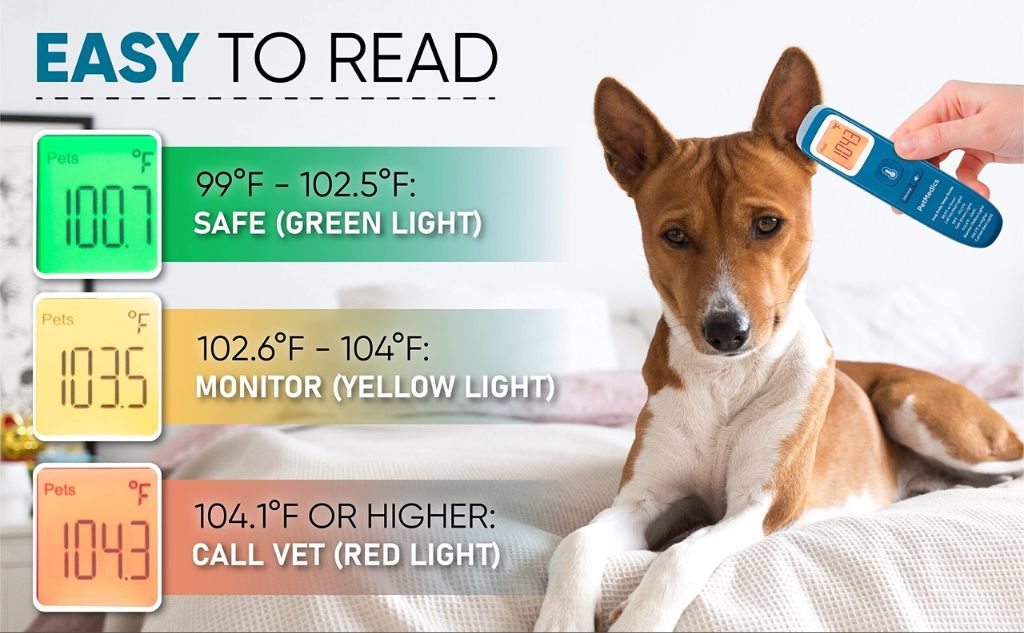Introduction
Infrared thermometers, also known as non-contact thermometers, are devices that can measure body temperature from a distance using infrared sensors. They work by detecting the infrared radiation emitted from an object, which can indicate its temperature. Infrared thermometers do not need to touch the surface of the object to get a temperature reading.
In recent years, infrared thermometers have become popular for taking temperature readings in dogs. Unlike traditional rectal thermometers, infrared thermometers provide a hands-off way to quickly measure a dog’s temperature without restraint or invasion of the rectum. Their ease of use and speed have made them a convenient tool for veterinarians and pet owners.
Normal Dog Temperature
The normal body temperature range for dogs is typically between 100-102.5 degrees Fahrenheit (38-39.2 degrees Celsius) according to VCA Animal Hospitals (https://vcahospitals.com/know-your-pet/taking-your-pets-temperature). This normal temperature allows the chemical reactions in a dog’s body to occur properly. A dog’s normal temperature may vary slightly depending on factors like breed, age, time of day, and activity level.
As Lincolnwayvet.com explains, temperatures under 99.5 degrees F or over 102.5 degrees F in dogs can indicate a medical problem that requires veterinary attention (https://lincolnwayvet.com/blog/what-is-a-dogs-normal-temperature/). Monitoring your dog’s temperature and watching for any significant changes from their normal baseline temperature is important for detecting potential illnesses early.
How to Use Infrared Thermometer on Dog
Using an infrared thermometer to take your dog’s temperature is quick and easy. However, proper technique is important for an accurate reading. Here are some tips for using an infrared thermometer on dogs:
Aim the thermometer at your dog’s inner ear canal. Gently pull back the flap of their ear and point the thermometer inside. Make sure to get it as deep into the canal as possible without touching the eardrum. The canal must be free of dirt, wax or moisture for the most precise reading.
Take 3-5 measurements, waiting a minute between each one. Dogs’ temperatures can fluctuate, so several readings give a better average. Make sure your dog remains still during each measurement.
Hold the thermometer perpendicular to the ear canal, about 1-2 inches away. Don’t press it directly against the skin. Take the measurement by pressing the button when aimed correctly.
Always follow the product instructions for proper positioning and use. Different infrared thermometer models have slightly different specifications.
Avoid taking the temperature when your dog is hot, excited, or has just exercised. Wait 10-15 minutes for their temperature to stabilize first for optimal accuracy.
Be gentle and positive to keep your dog calm. Anxiety may elevate their temperature. Offer treats and praise to make it a pleasant experience.
Compare your infrared readings to a rectal thermometer if unsure. Rectal remains the gold standard, but infrared is less invasive.
Advantages of Infrared Thermometers
Infrared thermometers offer several key advantages for taking a dog’s temperature compared to traditional rectal thermometers:

Touchless and Quick Measurement – Infrared thermometers provide a touchless, non-invasive way to get a temperature reading in seconds, with just a quick scan of the dog’s ear canal or inner eyelid. This is much faster and less stressful than inserting a rectal thermometer and waiting for the reading. According to research, infrared readings taken at the ear canal provide temperature measurements as accurate as rectal temperatures. [insert url 1 here]
Reduced Stress – Having a rectal thermometer inserted can be uncomfortable and scary for dogs. The quick, hands-free infrared measurement is much less stressful and allows the dog’s temperature to be taken with minimal restraint. This makes the process easier on both the dog and owner. One study found that infrared thermometer measurements elicited significantly less stress behaviors in dogs compared to rectal thermometers. [insert url 2 here]
Disadvantages
Using an infrared thermometer to take a dog’s temperature has some downsides compared to other methods like rectal thermometers. One key disadvantage is that infrared thermometers are generally less accurate than rectal thermometers, according to research comparing rectal and infrared thermometer readings in dogs (https://www.sciencedirect.com/science/article/pii/S2451943X20300338). Rectal thermometers directly measure the dog’s core body temperature, while infrared thermometers measure surface temperature, which can vary based on environmental conditions.
Another disadvantage is that room temperature and other environmental factors can impact the reading from an infrared thermometer. If the room is very warm or cold, the surface temperature of the dog may be higher or lower than their actual core body temperature. Taking the reading in a room closer to normal room temperature will provide a more accurate measure of the dog’s temperature.
Troubleshooting Tips
Using an infrared thermometer on dogs can sometimes yield inaccurate readings if not done properly. Here are some common issues to watch out for:
Incorrect positioning – The thermometer should be pointed at the dog’s inner ear canal or rectum to get an accurate reading. Pointing it at the outer ear or surface of the skin will result in an incorrect temperature.
Room temperature – Very hot or cold ambient temperatures can affect the reading. Take the dog’s temperature in a comfortable room temperature environment.
Squirming dog – Dogs that are restless or squirmy may make it difficult to get an accurate pointed reading. Have someone help hold the dog still if needed.
Low battery – Replace batteries regularly to ensure the infrared thermometer has ample power to give a precise reading.
Dirty lens – Gently clean the infrared lens periodically to avoid dust or debris affecting the accuracy.
User technique – With practice, the proper positioning and use of the thermometer will become second nature. Follow the manufacturer guidelines for best results.
By watching out for these common issues, infrared thermometer readings can be optimized for accuracy in monitoring a dog’s temperature.
When to Use Rectal Instead
While infrared thermometers provide a quick and non-invasive way to measure a dog’s temperature, there are some situations when using a rectal thermometer is still recommended:

If you need the most accurate temperature reading possible – Rectal thermometers are still considered the gold standard for accuracy. The rectum provides a consistent internal measurement not affected by environmental factors.
Monitoring a seriously ill dog – For dogs with a suspected fever or infection, veterinarians will often recommend monitoring with rectal temperatures to catch any dangerous spikes or drops in body temperature.
Overall, infrared thermometers still provide reasonably accurate readings in most normal situations. But for ill dogs or when accuracy is critical, a rectal thermometer remains the preferred method. Just be gentle, use lubricant, and follow all safety precautions when taking a rectal temperature.
Interpreting Temperature Readings
It’s important to know how to interpret your dog’s temperature readings, as this can indicate if something is wrong. Here are some key things to look out for:
An elevated temperature in dogs is usually defined as anything above 102.5°F/39.2°C (Source). Some of the common causes include:
- Infection – This could be something like a urinary tract infection, skin infection, respiratory infection, etc.
- Inflammation – Conditions like arthritis or inflammatory bowel disease.
- Cancer – Dogs with cancer often run fevers.
- Reaction to medication or vaccines.
- Overexertion or heat stroke.

You should call your vet if your dog’s temperature is 103°F/39.4°C or higher. This indicates a significant fever that needs medical attention. Some signs to watch for that mean an urgent vet visit is needed include lethargy, vomiting, diarrhea, or other concerning symptoms along with the fever.
A low body temperature below 99°F/37.2°C can also be a cause for concern (Source). Potential causes include:
- Hypothyroidism
- Infection
- Circulatory system problems
- Drug reactions or poisoning
- Environmental exposure to extreme cold
Call your vet promptly if your dog has a temperature below 99°F along with lethargy, trembling, or other symptoms.
Recommended Models
There are several good infrared thermometer options for taking a dog’s temperature quickly and accurately without contact. The PetMedics Non-Contact Digital Pet Thermometer is a top choice that provides fast, accurate readings with a response time of just 1 second. It has a measurement range of 89-108°F and is easy to use with a simple point and click design. The LCD display is easy to read and it remembers the last 32 temperature readings. It runs on AAA batteries so no charging is required.

Another good option is the iProvèn DTIR-1 Infrared Thermometer which can take a temperature reading from 1-2 inches away from the dog’s ear canal or rectum. It delivers accurate readings in just one second and has a memory that stores the last 10 temperature readings. It runs on a 9V battery so it’s always ready when you need it.
For a budget option, the Etekcity Lasergrip 774 Infrared Thermometer provides fast and accurate non-contact temperature readings at an affordable price. It has a measurement range of -58 to 716°F and a distance to spot ratio of 12:1. It’s easy to use with just one-button operation.
Any of these reliable and accurate infrared thermometers will allow you to easily take your dog’s temperature without stress or discomfort to your pet.
Conclusion
Monitoring your dog’s temperature is an important way to check their health and wellbeing. Abnormal temperatures may indicate issues like infection, inflammation, or hormonal imbalances. Using an infrared thermometer provides a fast, easy method to take your dog’s temperature without stress or discomfort.
The key points are that infrared thermometers designed for pet use provide safer, more hygienic readings than traditional rectal thermometers. However, rectal temperatures are still more accurate and may be preferred in some situations. It’s important to monitor the ambient temperature and your dog’s activity level which can impact infrared readings.
By establishing your dog’s normal temperature range and looking for significant deviations, you can identify potential illnesses early and seek veterinary advice when needed. With some practice and patience, an infrared thermometer can be a useful addition to monitoring your dog’s health.